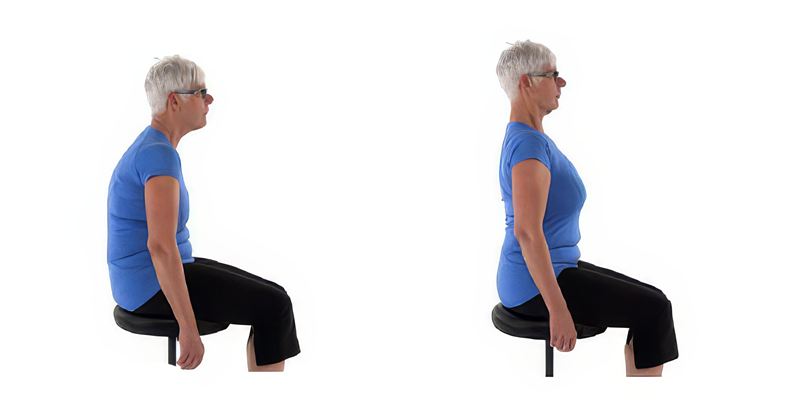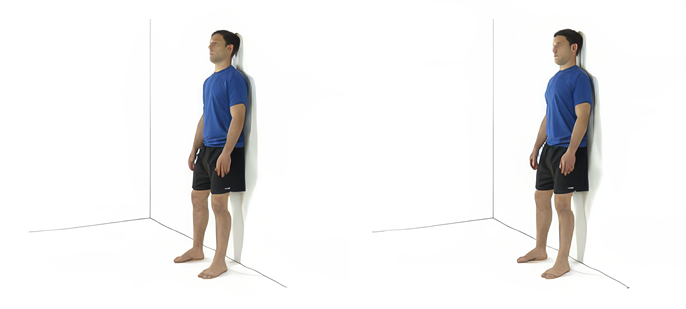Posture
Good posture also helps your body function well. It is important to reduce stress on your back by keeping your spine in the right positions while sitting, standing and doing daily activities.
Proper posture:
- promotes good spine alignment
- corrects muscle imbalances
- improves spinal stabilization
- protects the spine from increased compression
- helps reduce pain, allowing you to increase your activity levels and improving your quality of life
On the other hand, poor posture can change your appearance and cause discomfort, pain and disability by changing the way you move.
Correcting your posture
Posture correction exercises are unique to each person, as everyone has different posture patterns.
Correcting your posture can help you:
- maintain and strengthen your best posture
- prevent your posture from getting worse over time
- restore good movement
- correct muscle imbalances, which happen when some muscles are weak and overstretched while others are too tight
Be patient when working to improve your posture. It can take a long time to regain good posture and strength.
Awareness of posture and movement
Becoming aware of faulty posture is the first step to correcting it. Using a mirror or wall can help you see and correct the posture issue.
Quality of movement
Doing the movements correctly is more important than the number of repetitions. You may only need two or three repetitions to start.
We may also recommend that you focus on one or two parts of an exercise at first to help you perform the exercise correctly. We may gradually add other parts of the exercise to your routine.
Exercises and pain
It is important that posture correction and exercises do not cause you extra pain.
If you do feel extra pain, you may be doing the exercise incorrectly or your body may not be ready for the exercise. In these situations:
- check with your therapist to see if the exercise can be modified
- try changing your position often while standing or sitting
Practice
Changing how you move can take a lot of practice. You can correct your posture throughout the day by thinking of sitting tall, standing tall and walking tall.
Once you are aware of an incorrect movement, use the new correct movement in your daily activities. This is the best way to practice and regain good posture.
Posture correction exercises
You will need a few things to practice posture correction:
- 18-inch backless stool
- flat area of wall space
- 2 - 4 small towels
Sitting

Photo by Wibbi
- Place the stool against the wall so the edge touches the wall.
- Sit on the stool with your back against the wall. The stool height should allow your knees to be slightly lower than your hips. Do not sit on a low stool with knees higher than hips.
- Plant your feet firmly on the floor, hip-width apart with your knees directly over top of your feet.
- Keep your buttocks and back against the wall, lifting through your spine so your weight balances through your sit bones.
- Find your neutral spine position by:
rocking back on the sitting bones (spine flexes)
rocking forward on the sitting bones (spine arches)
finding the midpoint of these two movements so you have a gentle curve in your back - Imagine a string pulling up through your spine to lengthen it. Gently draw your shoulder blades back, opening up through the front of the chest and raising your breastbone.
- If your head does not touch the wall, tightly roll some towels and place the firm roll behind your head. The towel roll should feel comfortable and supportive. It should not feel like it is pushing your head forward
- Your face should be in a vertical position. Do not tip your head back to touch the wall. Instead, keep your chin gently tucked.
- Check the space between your back and the wall by placing a flat hand behind the lower back. There should be just enough space for your hand. If there is no room for your hand, place a small, flat folded towel behind the lower back to encourage a gentle curve there.
If there is too much room, place a small, flat folded towel in the space and gently pull your abdomen up and in to reduce the curve in your lower back slightly.
Standing

Photo by Wibbi
- Stand with your buttocks and back against the wall and your heels two to three inches from the base of the wall.
- If your head does not touch the wall, place a rolled towel behind your head. The towel roll should be firm and thick enough to be comfortable and supportive without pushing your head forward.
- Do not tip your head back to touch the wall. Your face should be vertical.
- Check the space between your lower back and the wall. There should be just enough space for your hand. If there is not enough room for your hand, your back is flattened. Place a small flat folded towel in the lower back area to encourage a gentle curve.
If there is too much room, place a flat folded towel in the space and gently pull your abdomen up and in to reduce the curve in your lower back.
Sometimes, the space in the lower back area and behind the neck are different in sitting and standing and you may have to adjust your towels accordingly.
Cues for good alignment
- press your feed against the floor
- lift the breastbone
- imagine a string pulling your spine taller
- keep shoulders and hips in a rectangle
Posture review and daily practice
It is important to do these exercises to stretch tight muscles, strengthen weak muscles and strengthen your bones over time. You should practice good posture until it becomes automatic.
Start the exercises slowly to allow your body to adapt, and make sure they do not cause pain. Practice correcting your posture while sitting and standing against the wall daily and then practice these positions throughout the day, even when you are not against the wall.
Over time, try to reduce towel support for your head. Your neck and trunk muscles should stretch with proper exercise, allowing you to find proper positioning without props.